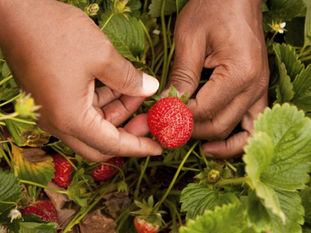
How to Divide Strawberry Plants: A Step-by-Step Guide to Multiplying Your Harvest
Aug 17, 2024
3 min read
If your strawberry plants have been thriving for a few seasons, you might notice they’re getting a bit crowded. But don’t worry - this is a good problem to have! As strawberry plants age, they develop larger crowns, which can be split to create new plants. This process, known as dividing, helps to rejuvenate your plants, giving them more space to grow and increasing your overall harvest. Here’s how to do it.
Why Divide Strawberry Plants?
Strawberry plants are perennials, meaning they live and produce fruit year after year. However, after a few seasons, the plants can become crowded and less productive. The solution? Dividing the crowns of your older plants. By splitting them, you not only reduce overcrowding but also get new plants that can start producing fruit sooner than seedlings. It’s like hitting the reset button for your strawberry patch!
When to Divide Strawberry Plants
The best time to divide your strawberry plants is during their dormant season, typically in late winter or early spring before new growth begins. This gives the divided plants time to establish themselves before the growing season kicks into high gear.

How to Divide Strawberry Plants
Here’s a step-by-step guide to dividing your old strawberry plants:
1. Prepare the Plant: Start by gently digging up the entire strawberry plant, being careful to keep as much of the root system intact as possible. You’ll want to loosen the soil around the plant first to avoid too much damage to the roots. Some damage can be unavoidable but do your best.
2. Identify the Crowns: Once the plant is out of the ground, you’ll see that it has multiple crowns, these look a little bit like trunks. Each crown is a small section of the plant with its own leaves and roots. Older plants often have several crowns that can be separated.
3. Split the Crowns: Using a sharp, clean knife or garden shears, cut through the root system to divide the plant into several smaller sections, each with its own crown and roots. Make sure each division has enough roots to support the plant as it establishes itself in the soil. This can also be done by carefully snapping the crowns if you don't have the tools on hand. Snapping is just as effective, it will do no more or less damage to the crown.
4. Replant the Divisions: Immediately replant the divided crowns in well-prepared soil, spacing them about 20cm apart to give them room to grow. Water them well and mulch around the base to help retain moisture.
5. Care for the New Plants: Keep the newly divided plants well-watered as they settle into their new homes. They’ll need a bit of extra attention initially, but once established, they’ll grow just like any other strawberry plant.
Benefits of Dividing Strawberry Plants
Dividing your strawberry plants not only helps to rejuvenate older plants but also increases your strawberry yield without the need to buy new plants. Plus, because these new plants are already mature, they’re likely to produce fruit faster than starting from seed, and sometimes even better than your first season of store bought plants.
In addition, dividing the crowns can help prevent disease and pests by improving air circulation around your plants, leading to healthier growth overall.
A Bountiful Harvest Awaits
By dividing your old strawberry plants, you’re setting yourself up for years of envy-worthy harvests. It’s an easy, cost-effective way to multiply your plants, refresh your garden, and enjoy even more of those delicious homegrown strawberries.
So, if your strawberry patch is looking a little too cozy, grab your garden tools and get dividing. Your future self (and your taste buds) will thank you!


